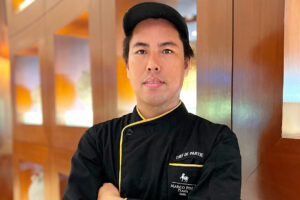Food exchange

CONSIDERING the country’s archipelagic layout, is it really possible to have an inclusive definition of Filipino cuisine?
BusinessWorld interviewed two chefs, both in a culinary exchange program with each other’s hotels, and found out what was the same, and what isn’t, among these islands (and why size matters).
Last week, Marco Polo Ortigas Manila launched Culinarya: a Filipino Heritage Cuisine Series at its buffet in Cucina. It concluded last Sunday, but on Monday this week, May 15, Marco Polo Ortigas sent their Executive Sous Chef, Rexsan Abarquez, to the Marco Polo Plaza in Cebu in an exchange of talent. The promotion at Ortigas had featured the Cebuano cuisine favored by its guest chefs, Chef de Cuisine at Marco Polo Plaza Cebu Riz Degamo, and chef Jonathan Cabuncal. Mr. Abarquez, meanwhile, will be presenting Kapampangan cuisine in Cebu until May 21.
Last Thursday, Ms. Degamo showed off Cebu’s famous version of lechon (whole roast pig), but also Balbacua (a stew made of ox skin), eel stew, Lansiao (a soup made of ox testicles), inasal (barbecue), and sinudlan (a Cebuano sausage). We kept coming back to the Tuslob buwa, a Cebuano street food made with pork brains sauteed in onions, garlic, and soy sauce, then spooned over puso, rice cooked in a coconut leaf casing.
Ms. Degamo credited Cebu’s cooking to a love of food and family. “Mahilig kaming kumain. Iyun ang nagbobond sa amin (we love to eat. That’s what binds us together),” she said. “When we cook, with love talaga (it’s really with love).” She also gives credit to the fact that their city is within arm’s reach of farms, so the ingredients come to their kitchens fresh.
For his part, Mr. Abarquez credited Pampanga’s reputation as a culinary capital to its proximity to water, as well as its international exposure as a military base during colonial times (by both the Spaniards and the Americans). “If not for the river, they wouldn’t be able to get the food they cook,” he said in English and Filipino.
He will be showing off Pampanga’s version of dinuguan called tintad — their version of the blood stew is cooked until dry and flavored with alibangbang (a leaf of a tree from the Bauhinia family, used as an herb). His version of sinigang (sour soup) will also be presented, flavored with guava and very young, very small tamarind leaves.
We emphasize the importance of the small leaves because Ms. Degamo noticed the size difference between Manila and Cebu. In Manila, everything is bigger, from the chilies to the spring onions, and eels. Bigger doesn’t always mean better though, because she notes that the smaller, fresher items she favors have stronger flavors. Mr. Abarquez said the same, noting the small leaves he likes to use, as well as the smaller and sharper leaves in Pampanga’s kangkong (water spinach) which he also praises for their flavor. “It’s from the forest,” he says about Pampanga’s herbs, noting also how they eschew instant mixes.
We retold a quip from a Cebuano we once interviewed: if a restaurant in Cebu can make it past six months, they’re already lucky. Ms. Degamo agreed. “Mahirap i-please (we’re hard to please),” she teased. “That’s true.” She pointed out that the short lifespans of restaurants are not just due to the diners’ pickiness, but also considerations of price relative to their high standards. Cebuanos, she said, might try a new restaurant for novelty, but won’t come back if the price isn’t commensurate to its quality — unless it’s for very special occasions. “Sarado talaga ‘yan (that will really close),” she said.
Still, she says about the Cebuano spread they laid out, “They’re the ones worth sharing.” — Joseph L. Garcia
Visit marcopolohotels.com and follow Marco Polo Ortigas Manila on Facebook and @marcopolomanila on Instagram for more information on upcoming promos.




